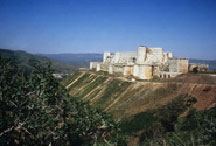Date of Inscription: 2006
Selection Criteria:
ii. to exhibit an important interchange of human values, over a span of time or within a cultural area of the world, on developments in architecture or technology, monumental arts, town-planning or landscape design;
iv. to be an outstanding example of a type of building, architectural or technological ensemble or landscape which illustrates (a) significant stage(s) in human history;
Brief Description
The two castles represent the most significant examples illustrating the exchange of influences and documenting the evolution of fortified architecture in the Near East during the time of the Crusades (11th to 13th century).
The Crac des Chevaliers was built by the Hospitaller Order of Saint John of Jerusalem from 1142 to 1271. With further construction by the Mamluks in the late 13th century, it ranks among the best-preserved examples of the Crusade castles. It is an archetype of the medieval castle, particularly of the military orders and includes eight round towers built by the Hospitallers and a massive square tower added by the Mamluks. Similarly, the Qal’at Salah El-Din (Fortress of Saladin), even though partly in ruins, still represents an outstanding example of this type of fortification, both in terms of the quality of construction and the survival of historical stratigraphy. It retains features from its Byzantine beginnings in the 10th century, the Frankish transformations in the late 12th century and fortifications added by the Ayyubids dynasty (late 12th to mid-13th century).
Source: http://whc.unesco.org/


